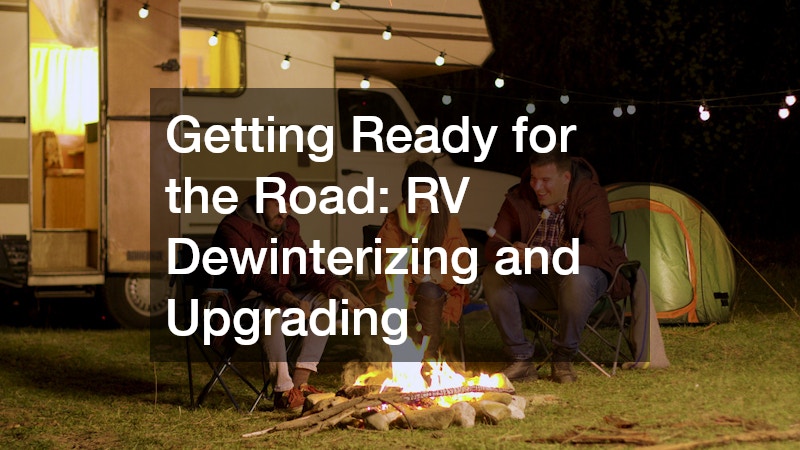
As winter thaws and the promise of warmer days returns, RV owners across the country begin to prepare their vehicles for another season of exploration. Getting your recreational vehicle ready for travel isn’t as simple as turning the key and hitting the road. After months of cold temperatures and inactivity, your RV needs a careful, thorough process to bring it back to optimal condition. That’s where RV dewinterizing and upgrading come into play. This checklist is a strategy for safety, comfort, and efficiency.
In this guide, we’ll walk you through the key areas that deserve attention as you transition your RV from winter storage to summer readiness. From examining mechanical systems to refreshing the interior, each step is essential in ensuring your vehicle not only functions properly but also enhances your travel experience. Our approach is organized into focused topics, making it easy to assess and improve every critical aspect of your RV.
This guide isn’t just about maintenance, but about transformation. Whether you’re heading to scenic national parks or quiet campgrounds, preparing now can prevent costly issues down the road and dramatically improve your overall experience. Let’s dive in and make sure your RV is ready for the road and better than ever before.
1. Inspect Your Camper

Before setting off on any journey, the first and most crucial step is a thorough inspection of your vehicle. This process ensures that no damage has occurred during winter storage and that everything is in working order for a new season. A comprehensive inspection goes beyond checking tires and fluids—it also involves looking for wear, leaks, or cracks that may compromise safety or comfort on the road.
Start by walking around the outside of your camper, examining seals, windows, and the roof for signs of weathering. Open storage compartments and access points to look for pests or moisture accumulation. Inside, test lights, appliances, and switches to make sure your electrical and mechanical systems function as they should. For those with travel trailers, ensure that the hitch, brakes, and frame are solid and rust-free.
This process is the heart of RV dewinterizing. When done carefully, inspecting your camper gives you the chance to identify small problems before they become major repairs. It’s also the perfect opportunity to plan upgrades and improvements while your RV is still stationary. Take notes on anything that needs attention and don’t rush—this inspection sets the tone for a successful and stress-free travel season.
2. Check the Drivetrain
The drivetrain is the mechanical backbone of your RV, and it’s critical to ensure it’s in top condition before venturing out. While this may seem like an intimidating part of vehicle maintenance, even basic checks can reveal a lot about your RV’s health. Components like the transmission, driveshaft, and differential are essential for efficient, reliable movement.
After months in storage, the transmission fluid may have settled or degraded, seals may have dried, and mechanical connections could be stiff. This is where trusted transmission shops come in—they can evaluate the health of your system, flush fluids, and correct any mechanical issues before they escalate. If you tow a vehicle or trailer, make sure your drivetrain is matched to the weight and that there’s no undue strain.
As part of RV dewinterizing, giving attention to your drivetrain can prevent breakdowns on remote highways and avoid expensive repair bills. Investing in a professional evaluation early in the season gives you peace of mind and extends the life of your RV. This is not the area to cut corners. Mobility is everything when it comes to road travel.
3. Power System Prep

Your RV’s power system is essential for lighting, heating, charging devices, and keeping appliances running smoothly. During storage, batteries can discharge, corrosion can form, and wires may be damaged by rodents or moisture. Reviving and checking your power system is a key part of safe and functional RV dewinterizing.
Begin by inspecting all batteries for corrosion and verifying their charge. Check connections and use a multimeter to test voltage at various outlets. If you notice flickering lights or inconsistent power delivery, it’s time to call in electrical repair professionals. They can troubleshoot deeper issues like faulty converters, damaged wiring, or overloaded circuits that could pose fire risks.
Many RV owners underestimate the complexity of their electrical systems until they experience a failure on the road. A detailed inspection and any necessary repairs now can mean uninterrupted comfort later. Whether you’re using shore power or solar, a healthy electrical system is non-negotiable for a successful trip.
4. Shine and Shield
After surviving snow, ice, and cold air, your RV’s exterior deserves some attention. Cleaning and protecting the outer surfaces not only improves appearance but also extends the life of your vehicle. Spring is the perfect time to restore your RV’s shine while adding layers of protection to fight off UV rays, road grime, and rain.
Washing your RV thoroughly is the first step. Look for faded paint, chalking, or stains that might have appeared during the winter. Consider applying ceramic coatings as part of your refresh. These provide a durable, protective barrier that helps repel water, prevent oxidation, and make cleaning easier down the road. This isn’t just about aesthetics; it’s long-term preservation.
As part of RV dewinterizing, exterior care plays a key role in overall upkeep. A well-maintained finish protects not only your investment but also signals that your RV is well-cared-for. Think of it like waxing your car, but more effective and longer-lasting. Taking pride in the look of your vehicle sets the stage for every adventure to come.
5. Drain and Refresh

One of the least glamorous but most vital parts of RV maintenance involves your water and waste systems. During winterization, lines are drained and antifreeze is often added to prevent freezing. Now, these systems must be flushed and restored for clean and safe use.
Start by draining any residual antifreeze from the freshwater tank and lines. Run clean water through all systems and check for leaks or strange odors. Sanitizing the water system is critical before drinking or cooking. For the waste system, professional septic pumping can clear out built-up material and ensure that valves and seals are functioning properly.
This step of RV dewinterizing is essential for hygiene and comfort. It’s not enough to simply rinse out tanks. You want to know everything is clean and functional for the season ahead. Trust professionals for the messier jobs and take the time to sanitize thoroughly. A fresh start here makes every shower and dishwashing session more pleasant.
6. Emergency Readiness
Preparedness is key to any successful road trip, and that includes having a solid emergency plan in place. No matter how thorough your pre-trip inspections and upgrades are, the unexpected can still happen, especially when you’re traveling with a large vehicle over long distances. Being ready for those scenarios reduces stress and keeps you safe in unfamiliar territory.
As you prep for the season, take inventory of your emergency gear. Make sure your spare tire is in good condition and that you have tools, flares, and a well-stocked first-aid kit on board. It’s also smart to research and identify local heavy towing services along your route. These professionals are equipped to handle large vehicles and can save you time, money, and frustration if your RV gets stuck or breaks down.
Part of RV dewinterizing is making sure your safety net is in place. Think beyond your mechanical systems—consider your backup options when things don’t go as planned. A well-prepared emergency plan isn’t just a safety measure; it’s a travel essential that gives you confidence wherever you go.
7. Upgrade Your Shades

Comfort and privacy are big components of enjoyable RV living, and your window treatments play a major role in both. After a long winter, it’s common to find faded, cracked, or worn shades that need replacing. Revitalizing your RV’s interior includes updating your blinds to reflect both function and personal style.
Modern custom blinds are not only visually appealing but also provide better light control, energy efficiency, and insulation. Whether you’re looking for blackout options for sleeping areas or lighter treatments for shared spaces, today’s selections are highly customizable to fit your RV’s unique dimensions. This is a quick upgrade that has an outsized impact on how your space feels.
When RV dewinterizing, don’t overlook the small touches that make a big difference. New window treatments freshen up the look of your living space and help control temperature as the weather shifts. They’re a great way to blend comfort with efficiency while preparing your RV for the season ahead.
8. Spruce Up Interiors
After being closed up for the winter, RV interiors can feel a little stale or dated. Refreshing your interior isn’t just about aesthetics—it’s about improving comfort and enjoyment during your travels. One highly effective way to breathe new life into your space is by upgrading your cushions, benches, and seating areas.
Many RV owners are turning to specialists in boat upholstery for custom fabric work that can withstand the unique demands of road travel. These professionals understand the importance of durability, water resistance, and precise fit. Reupholstering dining nooks, sofas, or driver and passenger seats can make your space feel brand-new and more tailored to your needs.
During RV dewinterizing, addressing worn upholstery elevates your RV from functional to luxurious. Whether you go with a bold pattern or a subtle neutral, refreshed cushions and surfaces make the interior more inviting. It’s an upgrade that boosts daily enjoyment and adds long-term value to your vehicle.
9. Frame and Fix
The structural integrity of your RV is what keeps it safe on the road. Time, weather, and vibrations can all take a toll on frames, supports, and joints, especially in older vehicles. Spring is the right time to inspect these areas for signs of rust, fatigue, or cracking.
If you discover any weak points in your frame or support systems, professional welding services can reinforce and repair those areas. Skilled welders can address everything from minor frame reinforcement to full bracket replacements. It’s also a good time to modify mounts or install reinforcements if you plan to carry additional gear this season.
In the process of RV dewinterizing, addressing structural repairs ensures your RV is ready for thousands of miles ahead. Strong welds mean fewer worries when navigating bumpy roads or towing. This kind of work may not be flashy, but it’s foundational, and your safety depends on it.
10. Hitch Up Smarter
Whether you’re towing a camper or using a separate tow vehicle, having the right hitch setup makes all the difference in control, safety, and convenience. Trailer hitches and towing accessories need to be carefully matched to your setup and checked for wear after winter storage.
Many RV owners turn to aftermarket truck modifications to improve their towing systems. These upgrades can include adjustable hitches, reinforced mounting points, sway control systems, or custom electrical hookups for lights and brakes. The right combination improves towing performance, reduces sway, and allows for easier loading and unloading of your travel gear.
As part of RV dewinterizing, don’t forget the connection between your RV and your vehicle. A secure, well-designed hitch system is what makes travel trailers and fifth-wheels roadworthy. Investing in the right modifications now gives you peace of mind every mile of your journey.
Ready for the Road
Preparing your RV for the road after a long winter isn’t just about dusting things off—it’s about creating a reliable, comfortable, and safe travel experience. From mechanical inspections to aesthetic upgrades, each step you take now helps prevent breakdowns, ensures system functionality, and enhances your overall enjoyment once the journey begins. Taking the time to thoroughly examine, repair, and refresh your RV is an investment in peace of mind.
The concept of RV dewinterizing is more than just reversing the effects of winterization. It’s a seasonal reset that allows you to evaluate your vehicle and bring it to its full potential. It’s the perfect time to not only restore what’s necessary but to elevate what’s possible. Whether you’re planning long hauls across the country or quiet weekends in the mountains, taking a thoughtful, structured approach to your RV setup will pay off with smooth travels and fewer surprises.
So before you pack the coolers and program the GPS, take the time to fully ready your vehicle using this guide as your checklist. Getting ready for the road means more than turning the key. It means preparing with care, attention, and excitement for the adventures that lie ahead.




